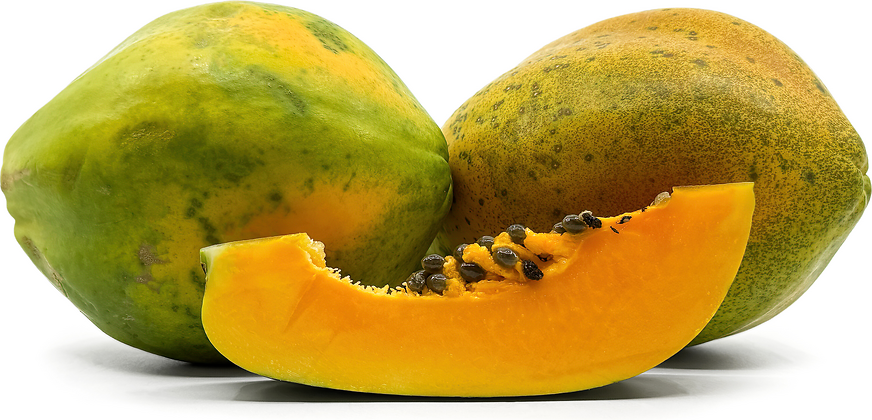


Red Paw Paw
Estimated Inventory, lb : 0
Description/Taste
Red Paw Paws are variable in size, depending on the specific variety and maturity at harvest, and generally average 10 to 50 centimeters in diameter. The fruits range in shape from pyriform, round to oval with a straight or curved middle, and the ends are typically tapered to blunt or pointed tips. The skin is thin, taut, firm, waxy, and semi-smooth and ripens from green to shades of mottled yellow-green, yellow, or orange when ripe. The skin may also be covered in superficial specks and markings that do not affect the quality of the flesh. Underneath the surface, Red Paw Paws showcase flesh in shades of red and orange, encasing a central cavity filled with small, hard, and round black seeds. The flesh is firm when young, and as it ripens, it becomes soft, aqueous, and succulent. Red Paw Paws are typically consumed ripe and have a fragrant, fruity, floral, and musky flavor. The seeds are also edible and have a peppery, warm, and pungent taste.
Seasons/Availability
Red Paw Paws are available year-round, with a peak season in the fall and spring.
Current Facts
Red Paw Paw, botanically classified as Carica papaya, is a tropical fruit belonging to the Caricaceae family. The name Paw Paw is a general descriptor primarily used in Australia to describe varieties of papaya, and Red Paw Paw refers to red-fleshed types sold in commercial markets. Several name variations are also used in Australian markets, including Papaw and Pawpaw. Historically, Paw Paw was used to label yellow-fleshed papaya varieties, but over time, the name became a catch-all term for red, orange, and yellow-fleshed fruits. For the purposes of this article, the Red Paw Paws referenced are focused on the varieties available in Australian markets. Red Paw Paw varieties are favored for their fast-growing qualities, productive nature, and fragrant fruits. The main types of Red Paw Paw sold commercially in Australia include Sunrise Solo, Southern Red, Sunny Red, Dwarf Red Lady, Ruby Rise Red, Red Army, and Hybrid 29. Red Paw Paws are produced as a specialty fruit and sold in markets for various culinary uses.
Nutritional Value
Red Paw Paws vary in nutritional content, depending on the specific variety. Papayas, in general, are a source of vitamins C and E to strengthen the immune system and guard the cells against the damage caused by free radicals. Papayas also provide fiber to regulate the digestive tract, calcium and phosphorus to support bones and teeth, and iron to develop the protein hemoglobin for oxygen transport through the bloodstream. Other nutrients include potassium to balance fluid levels within the body, magnesium to control nerves, and zinc, copper, folate, beta-carotene, and vitamin K. In Australia, various papaya extracts are also used in natural skincare treatments.
Applications
Red Paw Paws have a floral, fruity, and musky taste suited for fresh and cooked preparations. The fruits are consumed ripe and are savored for their tender flesh. Ripe Red Paw Paws are popularly sliced and tossed into green salads or mixed into fruit medleys. They are also used as a fresh topping over granola, yogurt, and smoothie bowls or blended into pancake batter. In Australia, Red Paw Paws are commonly added to smoothies and fruit juices or pureed into dressings and sauces. The fruits are also blended and frozen into popsicles, ice cream, and sorbet. In addition to fresh preparations, Red Paw Paws are incorporated into baked goods and used as flavoring in desserts such as cheesecakes, pies, crumbles, turnovers, and bread. Red Paw Paws are also simmered into jams, jellies, and syrups and used in mousse and pudding. Red Paw Paws pair well with fruits such as mango, coconut, pineapple, lime, and avocado, herbs such as lemongrass, cilantro, and mint, and nuts including peanuts, macadamia, and walnuts. Whole, unopened Red Paw Paws should be ripened at room temperature. Once ripe and ready to eat, the fruits will keep in the refrigerator for up to five days but should be immediately consumed for the best quality and flavor.
Ethnic/Cultural Info
Select varieties of Red Paw Paw were promoted in 2024 through the inaugural Papaya Week held in Queensland, Australia. Papaya Week ran between March 18th and 24th and was designed to promote the fruits grown locally in the region of Mareeba. The majority of red-fleshed papayas in Australia are commercially produced in Mareeba, and Skybury Farms, one of the creators of Papaya Week, was the first commercial plantation in Mareeba to introduce larger red papaya varieties. Skybury Farms partnered with Beemart, a regional produce retailer, to launch Papaya Week to encourage awareness of the health benefits surrounding papayas. Local restaurants also participated in the week, creating papaya-centric dishes to attract public attention. Beyond Papaya Week, Skybury Farms also uses excess fruits from their red-fleshed papaya crop to make alcoholic beverages for sale as a specialty product.
Geography/History
Carica papaya is native to the Americas, and wild descendants have been naturally growing since ancient times in the lowlands of Eastern Central America, spanning from Mexico to Panama. Indigenous populations in Mesoamerica first domesticated the species, and over time, new types were created with improved cultivation traits. Seeds were eventually carried from the Americas to the Caribbean and Europe by Spanish and Portuguese explorers around the 16th century, and after its introduction to Europe, Carica papaya was spread worldwide. Early Carica papaya species were thought to have been present in Australia since the 19th century for medicinal studies, and several years later, the species was being grown for commercial sale. In Australia, Carica papaya fruits are known as both Paw Paws and papayas, and the names are used interchangeably in some commercial markets. Today, Red Paw Paws are cultivated in regions of Northern and Central Queensland, the Northern Territory, and Western Australia. The fruits are sold domestically throughout local markets, supermarkets, and wholesalers and are also exported internationally.








